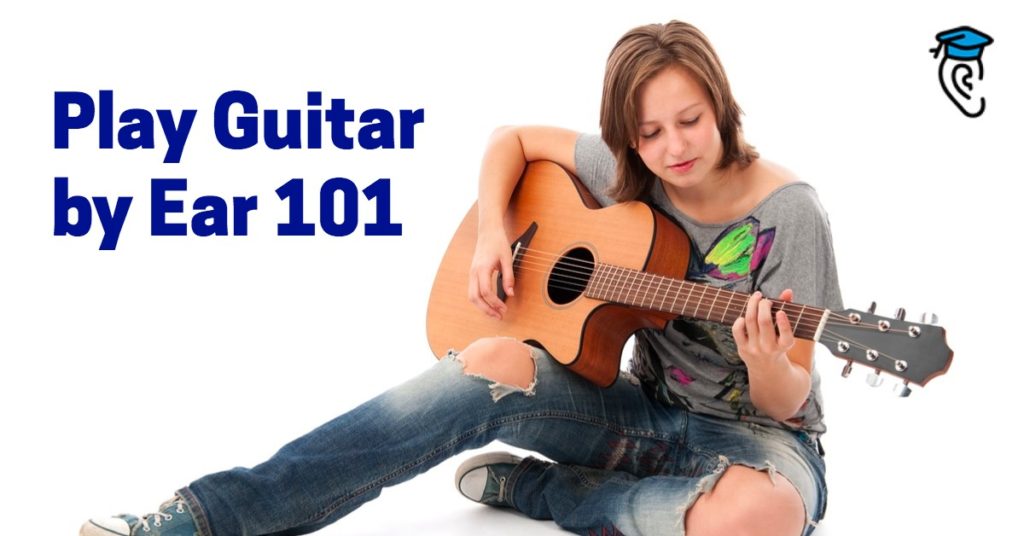Wouldn’t it be awesome to be one of those guitarists who just shows up and jams? No sheet music, no chord charts, no endless YouTube tutorials… How do they magically seem to know and play every song—even songs they never heard before?
Well, if you think it’s because they spend 25 hours a day, fingers-to-the-fretboard, memorizing every song under the sun, you may be surprised! While they may practice a good deal, their calloused fingers are often matched by well-honed ears.
Read on to discover why your ears are the key to true freedom on the fretboard and the essential areas to study if you want that seemingly-magical ability to play any song on guitar.
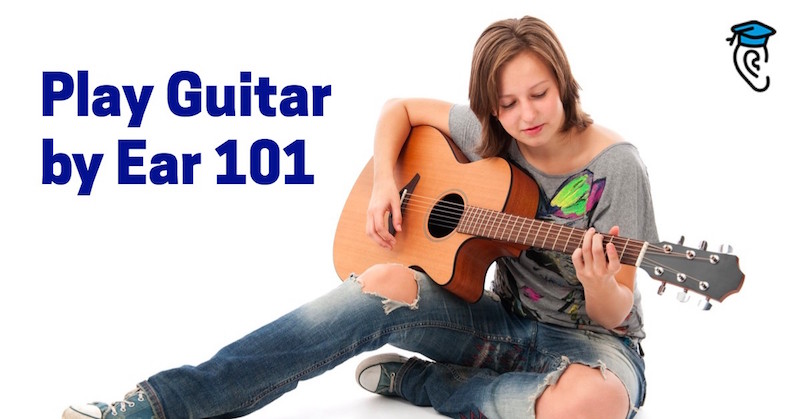
Ear Training: Don’t Fret!
All the guitarists I know just can’t keep their hands off their instruments. Why waste time with ear training when you could be playing guitar? This is why: you will learn more, better, and faster. Who doesn’t want that?
Some more good news: many ear training exercises work even better with guitar in hand!
So what are you waiting for? Explore these four ear training areas and expand into the guitarist you always dreamed of being.
1. Pitch
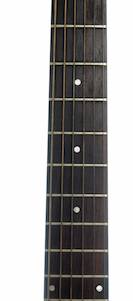 Pitch is about as fundamental as it gets in music and ear training. We’re talking vibrations: the very stuff that each note is made of. Pitch ear training is all about hearing the notes and how they relate to one another. There are several different directions here:
Pitch is about as fundamental as it gets in music and ear training. We’re talking vibrations: the very stuff that each note is made of. Pitch ear training is all about hearing the notes and how they relate to one another. There are several different directions here:
High and Low
First, hone your core sense of the “highness” or “lowness” of sound. This is referred to simply as pitch ear training. This can be a real ear-opener for rhythm guitarists, who tend to experience the chunks of sound (i.e. chords) but overlook the individual notes.
It’s All Relative
Once you’ve mastered single note pitches, the mother of all ear training is learning to hear relative pitch. One common approach is interval ear training which lets you learn how near or far notes are from each other.
These intervals are given names which are loosely based on scales (more on that in a moment). They are easy to visualize on a guitar by simply counting frets.
One small wrinkle: because the names of intervals are based on scales, which are mixtures of whole steps (two frets) and half steps (one fret), the number of frets will not directly match the name of the interval. Here are some examples:
| Interval | Frets |
|---|---|
| Major Second | 2 |
| Major Third | 4 |
| Perfect Fourth | 5 |
| Perfect Fifth | 7 |
Note: Always remember to count the fret that you’re starting on for the first note, the ones that you skip over, and the one for the note that you land on.
Of course, jumping across strings will add a whole new twist, depending on the string-to-string interval.
Once you can identify these intervals by ear and play them on your guitar, you’re well on your way to grabbing those cool riffs right out of thin air! Since you’ll be learning to hear them harmonically as well, you’ll be able to build your own new chord voicings too.
→ Learn more about interval ear training on guitar
Strike a Chord
Every guitarist is familiar with chords, whether you play rhythm or lead, acoustic or electric. But did you know that chords are actually made up of intervals stacked on top of each other? You can train your ear to recognise different types of chord using your relative pitch.
Even better, when you play through a chord progression the movement from one chord to another is also a form of relative pitch.
See why I called relative pitch the “mother of all ear training”?
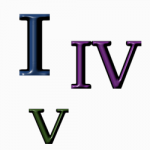 You might be used to thinking about chords only by letter name and quality, like “C major”, “A minor” and so on, but chords can be identified based on number as well as letter, reflecting their specific musical role in the progression. Measured from the root of the I chord, the root of the IV chord is up a fourth, and the V chord up a fifth, and so on. Interval ear training, at your service!
You might be used to thinking about chords only by letter name and quality, like “C major”, “A minor” and so on, but chords can be identified based on number as well as letter, reflecting their specific musical role in the progression. Measured from the root of the I chord, the root of the IV chord is up a fourth, and the V chord up a fifth, and so on. Interval ear training, at your service!
Are you starting to see how all these relative pitch skills connect together?
Scale it Up
Another related form of pitch ear training teaches you to hear each pitch’s role in the musical scale. The ancient system known as solfa, or solfeggio, assigns a specific syllable to each scale degree. Ear train with solfa, or with a number system for the notes of the scale, and you will expand your awareness of why melodies, chords and solos sound the way they do.
Let it Flow
By now you will have realized that, besides duplicating the sounds of other guitarists, you will be able to use your well-trained ears to bring forth the music you hear in your own head. Musical creativity can be yours.
Whether you’re improvising, creating a new riff, lead, or a whole song, with pitch ear training you’ll be ready to share your good vibrations with others!
2. Rhythm
While many guitarists stop at pitch ear training, being able to identify rhythms and rhythmic patterns may be even more important.
Try this experiment: grab anyone with a set of ears, and play for them a simple, recognizable melody in two ways: first, all the right notes with the wrong rhythms, then all the wrong notes with the right rhythm.
Your audience probably had a hard time with the first try—but almost immediately recognized the second, even with all the wrong notes!
Or have you ever noticed that when you’re trying to learn a song and find the right chords on your favorite tabs site, somehow it still doesn’t sound right? Chances are that rhythm ear training is the missing piece.
If you’re going to cover a song, or play within a certain style, matching the strum pattern, timing, and tempo matters a lot to your audience. With rhythm mastery you can even feel free to depart from it intentionally and the creativity will make your performance even more powerful.
3. FX and Tone
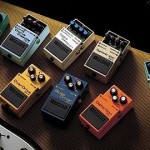 What? There’s ear training for that? Let’s face it: no matter how fast you fly across the frets, nobody cares if you don’t have that sound. Even once you pick your peck of pickled pedals, factory presets aren’t going to cut it if you want a unique and professional sound. Audio FX ear training will guide your journey through the dizzying array of electronic gizmos available to today’s guitarist.
What? There’s ear training for that? Let’s face it: no matter how fast you fly across the frets, nobody cares if you don’t have that sound. Even once you pick your peck of pickled pedals, factory presets aren’t going to cut it if you want a unique and professional sound. Audio FX ear training will guide your journey through the dizzying array of electronic gizmos available to today’s guitarist.
The more you play, the more you’ll want to find guitar tones that are uniquely your own. With audio effects ear training, that process will develop with much more intention and produce better results sooner.
4. Song-Writing
Is song writing an ear training exercise? When you think about it, a song is the structure that brings all of what we’ve discussed together. Learn that structure, and you’ll know what to do next—whether you’re writing your own song or learning someone else’s.
Most songs are made up of certain parts (intro, verse, chorus, bridge, etc.) and built from some fundamental elements (notes, rhythms, harmonies, instrumentation, etc.) but musicians are constantly innovating new song-writing techniques that you can continue to train your ears for.
By learning the musical characteristics of song structures and what tends to follows what, you’ll magically know what to do, even if you’re jamming on a song you never heard before!
How to Play Guitar by Ear
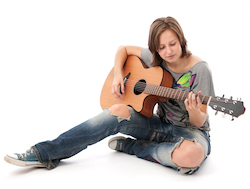 They may not strum, pick, run around the fretboard or stomp a pedal, but your ears are as important as your fingers if you’re aiming to become the guitarist of your dreams.
They may not strum, pick, run around the fretboard or stomp a pedal, but your ears are as important as your fingers if you’re aiming to become the guitarist of your dreams.
The coolest thing about it? Ear training transforms music theory from a “yawner” academic class into a awesome, transformative tool you can master. And with websites like Musical U, you don’t have to go it alone.
So, are you ready to double the effectiveness of your practice, smoke those impromptu jams and sit in with the big guys? Playing guitar by ear is no magic secret. Open your ears and let your fingers fly!

